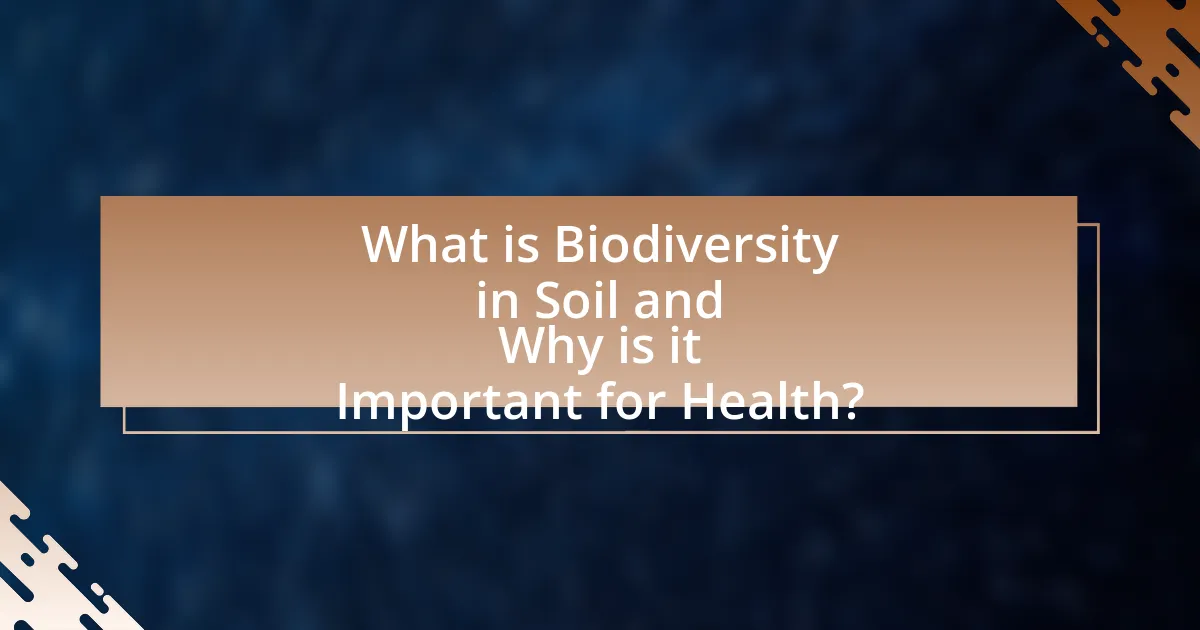Biodiversity in soil encompasses a wide range of organisms, including bacteria, fungi, protozoa, and larger fauna, which play vital roles in enhancing soil health and fertility. This article examines the importance of soil biodiversity for ecosystem resilience, nutrient cycling, and pest management, highlighting the interactions among soil organisms and their contributions to agricultural productivity. It also discusses practical strategies for promoting soil biodiversity, such as crop rotation, cover cropping, and reduced tillage, while addressing challenges like pollution and climate change that threaten soil ecosystems. By implementing sustainable practices, individuals and farmers can significantly improve soil health and biodiversity, ultimately supporting food security and environmental sustainability.

What is Biodiversity in Soil and Why is it Important for Health?
Biodiversity in soil refers to the variety of organisms, including bacteria, fungi, protozoa, nematodes, and larger fauna like earthworms, that inhabit the soil ecosystem. This diversity is crucial for health because it enhances soil fertility, promotes nutrient cycling, and improves resilience against pests and diseases. Research indicates that diverse soil communities contribute to better plant growth and higher agricultural yields, which are essential for food security and human health. For instance, a study published in the journal “Nature” found that soils with higher biodiversity are more effective at decomposing organic matter and cycling nutrients, leading to healthier crops and ecosystems.
How does soil biodiversity contribute to ecosystem health?
Soil biodiversity significantly contributes to ecosystem health by enhancing nutrient cycling, improving soil structure, and promoting plant growth. Diverse soil organisms, including bacteria, fungi, and invertebrates, facilitate the breakdown of organic matter, which releases essential nutrients for plants. Research indicates that soils with higher biodiversity can store more carbon, thus mitigating climate change effects. Additionally, a study published in the journal “Nature” by van der Heijden et al. (2008) demonstrates that diverse microbial communities enhance soil fertility and resilience against pests and diseases, further supporting ecosystem stability and productivity.
What organisms are included in soil biodiversity?
Soil biodiversity includes a variety of organisms such as bacteria, fungi, protozoa, nematodes, earthworms, arthropods, and larger organisms like mammals and birds. These organisms play crucial roles in nutrient cycling, soil structure formation, and organic matter decomposition. For instance, bacteria and fungi are essential for breaking down organic materials, while earthworms enhance soil aeration and nutrient availability. Studies indicate that a diverse soil community can improve plant health and resilience, demonstrating the importance of maintaining soil biodiversity for ecosystem functionality.
How do these organisms interact within the soil ecosystem?
Organisms in the soil ecosystem interact through complex relationships that include mutualism, competition, and predation. For instance, mycorrhizal fungi form symbiotic associations with plant roots, enhancing nutrient uptake for plants while receiving carbohydrates in return. Additionally, bacteria decompose organic matter, releasing nutrients that are accessible to plants, while also competing with other microbial species for resources. Soil fauna, such as earthworms, aerate the soil and facilitate nutrient cycling, which benefits both plants and microorganisms. These interactions contribute to soil health by maintaining nutrient availability, enhancing soil structure, and promoting biodiversity, which is essential for ecosystem resilience.
What are the key benefits of promoting biodiversity in soil?
Promoting biodiversity in soil enhances ecosystem resilience, improves soil fertility, and supports plant health. Diverse soil organisms, such as bacteria, fungi, and earthworms, contribute to nutrient cycling, which increases the availability of essential nutrients for plants. Research indicates that soils with higher biodiversity can better withstand environmental stressors, such as drought and disease, leading to more stable agricultural yields. Additionally, a study published in the journal “Nature” found that increased microbial diversity in soil correlates with improved soil structure and water retention, further benefiting plant growth and agricultural productivity.
How does soil biodiversity enhance nutrient cycling?
Soil biodiversity enhances nutrient cycling by facilitating the breakdown of organic matter and the transformation of nutrients into forms accessible to plants. Diverse soil organisms, including bacteria, fungi, and invertebrates, contribute to this process by decomposing organic materials, which releases essential nutrients like nitrogen and phosphorus. Research indicates that soils with higher biodiversity exhibit increased microbial activity and greater nutrient availability, leading to improved plant growth and ecosystem health. For instance, a study published in “Nature” by Cardinale et al. (2012) demonstrated that ecosystems with diverse microbial communities had enhanced nutrient cycling rates compared to those with less diversity. This evidence underscores the critical role of soil biodiversity in maintaining nutrient dynamics within ecosystems.
What role does soil biodiversity play in pest and disease management?
Soil biodiversity plays a crucial role in pest and disease management by enhancing ecosystem resilience and promoting natural pest control mechanisms. Diverse soil organisms, including bacteria, fungi, and nematodes, contribute to the suppression of soil-borne pathogens and pests through various interactions, such as competition, predation, and the production of antimicrobial compounds. Research indicates that soils with higher biodiversity can reduce the incidence of crop diseases by up to 50%, as diverse microbial communities can outcompete harmful pathogens for resources and space. This relationship underscores the importance of maintaining soil biodiversity to improve agricultural health and sustainability.

How Can We Promote Biodiversity in Soil?
To promote biodiversity in soil, implement practices such as crop rotation, cover cropping, and reduced tillage. Crop rotation enhances soil health by preventing nutrient depletion and disrupting pest cycles, while cover cropping adds organic matter and improves soil structure. Reduced tillage minimizes soil disturbance, preserving microbial communities and enhancing biodiversity. Research indicates that these practices can increase soil organic carbon levels by up to 30%, thereby supporting a diverse range of soil organisms and improving overall soil health.
What practices can enhance soil biodiversity?
Practices that can enhance soil biodiversity include crop rotation, cover cropping, reduced tillage, and organic amendments. Crop rotation introduces diverse plant species, which can improve soil structure and nutrient cycling, while cover cropping protects soil from erosion and adds organic matter. Reduced tillage minimizes soil disturbance, preserving microbial habitats, and organic amendments, such as compost, provide essential nutrients and foster a diverse soil ecosystem. Research indicates that these practices can significantly increase microbial diversity and activity, leading to healthier soil and improved agricultural productivity.
How does organic farming contribute to soil biodiversity?
Organic farming enhances soil biodiversity by promoting a diverse ecosystem of microorganisms, fungi, and invertebrates. This farming method avoids synthetic chemicals, allowing natural soil organisms to thrive, which in turn improves soil structure and nutrient cycling. Research indicates that organic farms typically have higher levels of soil organic matter and microbial diversity compared to conventional farms, leading to healthier soil ecosystems. For instance, a study published in the journal “Soil Biology and Biochemistry” found that organic farming practices significantly increase the abundance and diversity of beneficial soil organisms, which are crucial for maintaining soil health and fertility.
What is the impact of cover cropping on soil health?
Cover cropping significantly enhances soil health by improving soil structure, increasing organic matter, and promoting microbial diversity. Cover crops, such as legumes and grasses, contribute organic material to the soil, which boosts nutrient availability and enhances soil fertility. Research indicates that cover cropping can reduce soil erosion by up to 90% and improve water retention, leading to better moisture availability for crops. Additionally, studies have shown that cover crops can increase soil microbial biomass by 30-50%, fostering a diverse soil ecosystem that supports plant growth and resilience against pests and diseases.
Why is soil management crucial for promoting biodiversity?
Soil management is crucial for promoting biodiversity because it enhances soil health, which supports a diverse range of organisms. Healthy soil provides essential nutrients, improves water retention, and fosters a habitat for microorganisms, plants, and animals. Research indicates that well-managed soils can increase microbial diversity by up to 50%, which is vital for ecosystem functions such as nutrient cycling and organic matter decomposition. Additionally, practices like crop rotation and reduced tillage have been shown to improve soil structure and promote the presence of beneficial species, further contributing to overall biodiversity.
How do tillage practices affect soil biodiversity?
Tillage practices significantly reduce soil biodiversity by disrupting soil structure and habitat. Conventional tillage, which involves turning over the soil, can lead to the loss of soil organisms such as earthworms and beneficial microbes, which are essential for nutrient cycling and soil health. Research indicates that reduced tillage or no-till practices can enhance soil biodiversity by preserving the habitat for these organisms, thereby improving soil quality and ecosystem functions. For instance, a study published in the journal “Soil Biology and Biochemistry” found that no-till systems can increase microbial biomass and diversity compared to conventional tillage, demonstrating the direct impact of tillage methods on soil biodiversity.
What are the effects of chemical fertilizers on soil organisms?
Chemical fertilizers negatively affect soil organisms by disrupting their natural habitats and reducing biodiversity. The application of these fertilizers can lead to an imbalance in soil pH and nutrient levels, which adversely impacts beneficial microorganisms such as bacteria, fungi, and earthworms. Research indicates that high concentrations of nitrogen and phosphorus from chemical fertilizers can create toxic conditions for these organisms, leading to decreased populations and diversity. For instance, a study published in the journal “Soil Biology and Biochemistry” found that long-term use of chemical fertilizers significantly reduced microbial biomass and diversity in agricultural soils, demonstrating the detrimental effects on soil health and ecosystem functioning.

What Challenges Exist in Promoting Soil Biodiversity?
Promoting soil biodiversity faces several challenges, including land use changes, pollution, and climate change. Land use changes, such as urbanization and intensive agriculture, disrupt natural habitats and reduce the diversity of soil organisms. Pollution from pesticides and fertilizers can harm beneficial microbes and invertebrates, leading to a decline in soil health. Climate change further exacerbates these issues by altering moisture levels and temperature, which can negatively impact soil ecosystems. According to a study published in “Nature” by Wall et al. (2015), these factors collectively threaten the resilience and functionality of soil biodiversity, making it difficult to maintain healthy soil ecosystems.
What are the main threats to soil biodiversity?
The main threats to soil biodiversity include habitat destruction, pollution, climate change, and the use of chemical pesticides and fertilizers. Habitat destruction, often due to urbanization and agricultural expansion, reduces the variety of environments where soil organisms can thrive. Pollution from industrial activities and agricultural runoff introduces harmful substances that can kill or disrupt soil organisms. Climate change alters temperature and moisture levels, affecting the survival and reproduction of soil species. Additionally, the application of chemical pesticides and fertilizers can lead to a decline in beneficial soil organisms, disrupting the natural balance of soil ecosystems. These factors collectively contribute to the loss of soil biodiversity, which is crucial for maintaining soil health and ecosystem services.
How does urbanization impact soil ecosystems?
Urbanization negatively impacts soil ecosystems by altering soil composition, structure, and biodiversity. The introduction of impervious surfaces, such as roads and buildings, leads to soil compaction and reduced infiltration, which disrupts natural water cycles and diminishes soil health. Additionally, urbanization often results in the loss of native vegetation, which further decreases soil biodiversity and the presence of beneficial microorganisms. Studies indicate that urban soils can have significantly lower organic matter content and microbial diversity compared to rural soils, which are essential for nutrient cycling and ecosystem resilience.
What role does climate change play in soil biodiversity loss?
Climate change significantly contributes to soil biodiversity loss by altering temperature and moisture patterns, which disrupts the habitats of soil organisms. Increased temperatures can lead to changes in microbial community composition, while altered precipitation patterns can affect soil moisture levels, impacting the survival and activity of various soil species. Research indicates that climate change can reduce soil organic matter, which is essential for maintaining diverse soil life, as it serves as a food source for many organisms. For instance, a study published in “Nature Climate Change” by Smith et al. (2020) highlights that rising temperatures can decrease microbial diversity by favoring certain species over others, leading to a decline in overall soil health and function.
How can we overcome these challenges?
To overcome challenges in promoting biodiversity in soil for better health, implementing sustainable agricultural practices is essential. These practices include crop rotation, cover cropping, and reduced tillage, which enhance soil structure and microbial diversity. Research indicates that diverse cropping systems can increase soil organic matter and improve nutrient cycling, leading to healthier soils. For instance, a study published in the journal “Agriculture, Ecosystems & Environment” by authors such as Teague et al. (2016) demonstrates that rotational grazing and cover crops significantly enhance soil biodiversity and health. By adopting these methods, farmers can effectively address the challenges associated with soil biodiversity loss.
What strategies can be implemented to restore soil biodiversity?
To restore soil biodiversity, strategies such as reducing chemical inputs, implementing crop rotation, and enhancing organic matter through composting can be effectively utilized. Reducing chemical inputs minimizes harmful effects on soil organisms, while crop rotation promotes diverse microbial communities by varying plant species and root structures. Enhancing organic matter through composting not only improves soil structure but also provides essential nutrients, fostering a thriving ecosystem. Research indicates that these practices can significantly increase soil microbial diversity, leading to improved soil health and resilience (Gonzalez et al., 2020, Soil Biology and Biochemistry).
How can community involvement aid in promoting soil health?
Community involvement can significantly aid in promoting soil health by fostering collaborative efforts in sustainable land management practices. Engaging local residents in activities such as community gardens, soil testing workshops, and educational programs enhances awareness of soil conservation techniques. Research indicates that community-led initiatives, like the “Soil Health Partnership,” have successfully improved soil organic matter and biodiversity through collective action and shared knowledge. These efforts not only empower individuals but also create a network of support that encourages the adoption of practices such as crop rotation, cover cropping, and reduced chemical use, all of which contribute to healthier soils.
What are some practical tips for promoting biodiversity in your soil?
To promote biodiversity in your soil, implement practices such as crop rotation, cover cropping, and reduced tillage. Crop rotation enhances soil health by preventing nutrient depletion and disrupting pest cycles, which can lead to a more diverse microbial community. Cover cropping introduces various plant species that improve soil structure, increase organic matter, and provide habitats for beneficial organisms. Reduced tillage minimizes soil disturbance, preserving the existing soil ecosystem and promoting the activity of earthworms and other soil fauna. Research indicates that these practices can significantly enhance soil biodiversity, leading to improved soil fertility and resilience (Source: “Soil Biodiversity and Soil Health,” by D. J. Pennock et al., 2020).
How can home gardeners enhance soil biodiversity?
Home gardeners can enhance soil biodiversity by incorporating diverse plant species, using organic amendments, and practicing crop rotation. Diverse plant species attract a variety of beneficial organisms, such as earthworms and microbes, which contribute to soil health. Organic amendments, like compost and mulch, improve soil structure and provide nutrients, fostering a thriving ecosystem. Crop rotation prevents soil depletion and disrupts pest cycles, promoting a balanced soil environment. Research indicates that gardens with higher plant diversity can support up to 50% more soil organisms, demonstrating the positive impact of these practices on soil biodiversity.
What resources are available for farmers to improve soil health?
Farmers can access various resources to improve soil health, including cover crops, compost, soil amendments, and educational programs. Cover crops, such as clover and rye, enhance soil structure and nutrient content while preventing erosion. Compost enriches soil with organic matter, promoting microbial activity essential for nutrient cycling. Soil amendments, like lime and gypsum, can correct pH imbalances and improve soil texture. Additionally, educational programs offered by agricultural extension services provide farmers with research-based practices and techniques for sustainable soil management, which have been shown to increase crop yields and enhance soil biodiversity.










